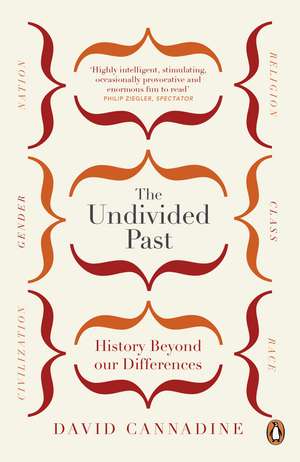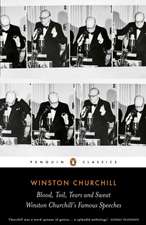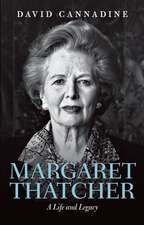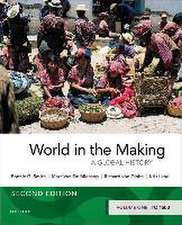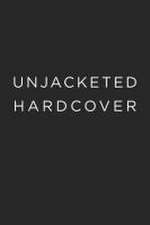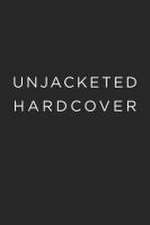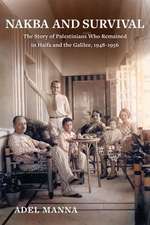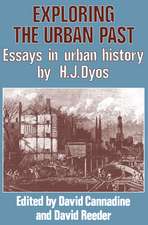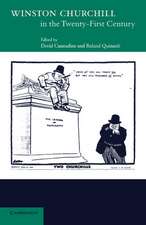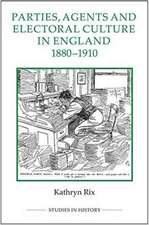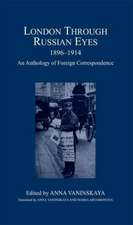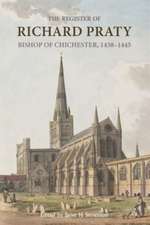The Undivided Past: History Beyond Our Differences
Autor David Cannadineen Limba Engleză Paperback – 2 apr 2014
Great works of history have so often had at their heart a wish to sift people in ways that have been profoundly damaging and provided intellectual justification for terrible political decisions. Again and again, categories have been found--religion, nation, class, gender, race, 'civilization'--that have sought to explain world events by fabricating some malevolent or helpless 'other'.
The Undivided Pastis an agonised attempt to understand how so much of the writing of history has been driven by a fatal desire to dramatizedifferences -to create an 'us versus them'. Is is above all an appeal to common humanity.
| Toate formatele și edițiile | Preț | Express |
|---|---|---|
| Paperback (2) | 82.25 lei 6-8 săpt. | |
| VINTAGE BOOKS – 13 ian 2014 | 92.77 lei 3-5 săpt. | |
| Penguin Books – 2 apr 2014 | 82.25 lei 6-8 săpt. |
Preț: 82.25 lei
Nou
Puncte Express: 123
Preț estimativ în valută:
15.74€ • 16.43$ • 13.03£
15.74€ • 16.43$ • 13.03£
Carte tipărită la comandă
Livrare economică 04-18 aprilie
Preluare comenzi: 021 569.72.76
Specificații
ISBN-13: 9780141036908
ISBN-10: 0141036907
Pagini: 352
Ilustrații: none
Dimensiuni: 129 x 198 x 20 mm
Greutate: 0.26 kg
Editura: Penguin Books
Colecția Penguin
Locul publicării:London, United Kingdom
ISBN-10: 0141036907
Pagini: 352
Ilustrații: none
Dimensiuni: 129 x 198 x 20 mm
Greutate: 0.26 kg
Editura: Penguin Books
Colecția Penguin
Locul publicării:London, United Kingdom
Notă biografică
Sir
David
Cannadine
is
Chair
of
the
National
Portrait
Gallery,
Dodge
Professor
of
History
at
Princeton
University
and
General
Editor
of
thePenguin
History
of
EuropeandPenguin
History
of
Britain.
He
is
a
Fellow
of
the
British
Academy
and
the
Chair
of
the
Blue
Plaques
Committee.
His
major
books
includeThe
Rise
and
Fall
of
the
British
Aristocracy,
OrnamentalismandMellon:
A
Life.
He
has
previously
taught
at
Cambridge,
Columbia
and
London
universities.
Recenzii
[Cannadine's]
great
strength
is
his
lucid
and
crushing
treatment
of
false
prophets
...
his
case
is
urgent,
as
the
news
demonstrates
every
day
...
Cannadine
is
frank
in
acknowledging
that
his
is
not
the
last
word
...
but
he
has
uttered
the
first
word
and
deserves
exhaustive
discussion.
His
plea
is
of
enormous
value.
It
should
be
heard
in
every
think
tank,
madrassa,
history
workshop
and
sixth
form
and
should
guide
the
utterances
of
statesmen
Cannadine marshals modern scholarship, a sure historical sweep, and a confident polemic ... Quite rightly, Cannadine denounces the collective, warring identities conjured up by [neoconservative scholars] and again highlights a broader history of cultural exchange ... this collection winningly combines history, politics, and contemporary culture in a refreshingly optimistic manner
An ambitious and wide-ranging exploration of the notion of human solidarity. It explores the concept by seeking to analyse what divides us, neatly sidestepping the need to list what we have in common ... an interesting and informative read
[An] impassioned plea ...The Undivided Pastshould earn applause ... The next time some tub-thumping loudmouth proclaims the timeless truth of a binary divide - between, say, 'Britain' and 'Europe' - throw this book at them
Highly intelligent, stimulating, occasionally provocative and enormous fun to read ...The Undivided Pastis a cry for tolerance ... It is a noble message and one that historians would do well to heed
Elegantly written and stimulating ... [Cannadine] goes much further than most academic historians in challenging the centrality of tensions based on nation, class, ethnicity and gender
Cannadine urges us to see through [prejudices] and past them, to get away from the old chestnuts of class, race, gender and the rest, and to concentrate on exploring what brings us together
Each chapter of Cannadine's book ... displays the incisive and original argument for which he is renowned ... Cannadine is surely right to insist on a recovery of the unchronicled swathes of human history dominated by cooperation and peace, rather than wars of race, religion or nationalism ... [The Undivided Pastdisplays] his characteristic style and ingenuity
Cannadine has produced a set of lively and informative essays that are leavened ... by a dry wit
Cannadine marshals modern scholarship, a sure historical sweep, and a confident polemic ... Quite rightly, Cannadine denounces the collective, warring identities conjured up by [neoconservative scholars] and again highlights a broader history of cultural exchange ... this collection winningly combines history, politics, and contemporary culture in a refreshingly optimistic manner
An ambitious and wide-ranging exploration of the notion of human solidarity. It explores the concept by seeking to analyse what divides us, neatly sidestepping the need to list what we have in common ... an interesting and informative read
[An] impassioned plea ...The Undivided Pastshould earn applause ... The next time some tub-thumping loudmouth proclaims the timeless truth of a binary divide - between, say, 'Britain' and 'Europe' - throw this book at them
Highly intelligent, stimulating, occasionally provocative and enormous fun to read ...The Undivided Pastis a cry for tolerance ... It is a noble message and one that historians would do well to heed
Elegantly written and stimulating ... [Cannadine] goes much further than most academic historians in challenging the centrality of tensions based on nation, class, ethnicity and gender
Cannadine urges us to see through [prejudices] and past them, to get away from the old chestnuts of class, race, gender and the rest, and to concentrate on exploring what brings us together
Each chapter of Cannadine's book ... displays the incisive and original argument for which he is renowned ... Cannadine is surely right to insist on a recovery of the unchronicled swathes of human history dominated by cooperation and peace, rather than wars of race, religion or nationalism ... [The Undivided Pastdisplays] his characteristic style and ingenuity
Cannadine has produced a set of lively and informative essays that are leavened ... by a dry wit
Extras
When I was coming up, it was a dangerous world, and you knew exactly who they were. It was “us versus them,” and it was clear who them [sic] was. Today, we’re not so sure who they are, but we know they’re there.
—President George W. Bush, quoted in the New York Times, April 16, 2006
The world is awash in divisions rooted in the human compulsion to believe our differences are more important than our common humanity . . . .[But] our common humanity is more important than our interesting and inevitable differences.
—President Bill Clinton, Giving: How Each of Us Can Change the World
This book sets out to explore and investigate the most resonant forms of human solidarity as they have been invented and created, established and sustained, questioned and denied, fissured and broken across the centuries and around the world, and as they have defined the lives, engaged the emotions, and influenced the fates of countless millions of individuals. It does so by looking at the six most commonplace and compelling forms of such identities, namely religion, nation, class, gender, race, and civilization. Sometimes regional, sometimes national, and sometimes more global in their compass and in the claims made on their behalf, these groupings have commanded widespread allegiance and commitment, on occasions for good, but often not, since every collective solidarity simultaneously creates an actual or potential antagonist out of the group or groups it excludes. Even if we confine ourselves to the twentieth century, there have been many such confrontations and conflicts variously described as religious wars, or national wars, or class wars, or gender wars, or race wars, or wars for civilization. And whatever the solidarity ties specific to our own time, analogous groupings and analogous conflicts have existed across the millennia and around the world, from Christians versus pagans during the later Roman Empire to the white supremacists versus anti- apartheid campaigners until 1994; and there is no reason to suppose that the twenty- first century will be free of such confrontations. As a consequence, it has come to seem almost axiomatic that the best way to understand past worlds, as well as present circumstances and our future prospects, is in the workings and outcomes of latent or actual conflicts between antagonistic identities, or of how things go in the great game of “us versus them,” exemplified in the words of President George W. Bush quoted above.1
What is perhaps most remarkable is how well the appeal of “us versus them” works over a range of categories, aggregations, and identities that are scarcely comparable. For much of recorded history the two most prominent have been (initially) religious affiliation and (subsequently) national allegiance. It is only in relatively recent times that they have been augmented, and in some measure superseded, by the secular, international trinity of class consciousness, gender awareness, and racial solidarity. And since the events of September 11, 2001, the even larger identity and more capacious category of civilization, earlier invoked by historians from Edward Gibbon to Arnold Toynbee, has made a comeback, embodied in the writings of Samuel P. Huntington, which were subsequently invoked by his neoconservative followers in the United States and by his New Labour admirers in the United Kingdom. But the fact remains that each of these solidarities is constituted around a distinctive axis of interest and awareness: religious cohesion is an expression of faith and belief (or, depending on one’s sympathies, of superstition and irrationality), and can be as much concerned with the next world as with this; national identity relies on a shared narrated memory and sense of geographical belonging, reinforced by a common language and culture and state power; class consciousness is seen as the outcome of the different relations of people to the modes of production, leading to the hostile solidarities of workers and employers; gender and race identities are partly the result of biology, but also of the meanings and antagonisms constructed and projected onto anatomical features shared by some human beings but not by others; while civilization is perhaps the most flexible form of human grouping, which can be defined according to any number of criteria. Yet however disparate and incommensurable, these collective identities have all been defined and reinforced through confrontation, struggle, and conflict— against an alternative religion, an enemy nation, a hostile class, the other gender, a different race, or an alien civilization. The result has been the serial reiteration of the Manichean view that the world is divided into conflicting groups, with a monolithic “good” on one side (those with “us”), and a no less monolithic “evil” on the other (those against “us”). This ultimately apocalyptic perspective has resonated on many terrible occasions throughout history, and it was vigorously and unapologetically reiterated by President George W. Bush in his final address from the Oval Office: “I have spoken to you often,” he told his fellow Americans, “about good and evil, and this has made some people uncomfortable. But good and evil are present in this world, and between the two there can be no compromise.”2 The trouble is, whether good and evil exist as such, the absolutes they imply have been ascribed with various degrees of literalism to every manner of perceived difference. And so a battle of cosmic significance might be claimed between Protestant and Catholic, America and Russia, employee and employer, women and men, black and white, or “the West” and Islam, confrontations in which each side seeks to galvanize its supporters by exaggerating their solidarity and virtue, and by imputing to the other side a no less exaggerated solidarity and wickedness.3 This impulse thus to sunder all the peoples of the world into belligerent collectivities has existed as long as humanity itself, and in our own day the easy recourse to such polarized thinking by many political leaders and public figures, and by pundits and commentators, is further exaggerated by an increasingly strident media. It has also been underscored by some historians who have been more concerned to legitimate the claims and urge the merits of one collective identity over and against any (or all) others than to take a broader view of the human past.4
During the last half century or so, the conventional wisdom that “the history of humanity is based upon the immemorial divisions of its peoples” has been reinforced by a growing academic insistence on the importance of recognizing the “difference” between collective groups.5 According to the anthropologist Clifford Geertz, “difference is what makes the world go round, especially the political world”; many of his colleagues as well as literary scholars and cultural critics would agree, and so do those historians who have focused their attention on the creation, perception, working, meaning, and significance of what they varyingly describe as “difference,” or “otherness,” or “alterity,” or “unlikeness,” or “dissimilarity.”6 Beyond doubt, such historical approaches have yielded significant work of enduring value, illuminating dimensions of human experience once unexamined; but as William H. McNeill, one of the pioneers of global history, has pointed out, the academic preoccupation with the binary simplicities of difference, and with the antagonisms based on them, results in a version of “the past as we want it to be, safely simplified into a contest between good guys and bad guys, ‘us and them,’ ” which disconcertingly resembles the polarized, apocalyptic perspective of President George W. Bush— or, indeed, of the late Osama bin Laden.7
But the fact that humanity is still here, that no one has vanquished “us” or “them” on either side of any of these divides, despite such “ultimate” confrontations and conflicts, suggests that there is a case for taking a broader, more ecumenical, and even more optimistic view of human identities and relations—a view that not only accepts difference and conflict based on clashing sectional identities, but also recognizes affinities and discerns conversations across these allegedly impermeable boundaries of identity, which embody and express a broader sense of humanity that goes beyond our dis-similarities.8 This alternative perspective is well put by the poet and civil rights activist Maya Angelou:
I note the obvious differences
Between each sort and type,
But we are more alike, my friends,
Than we are unalike.9
In the same vein, if more prosaically, the historian Timothy Garton Ash has deplored the “Manichean cultural dichotomies” that are peddled by a partisan media, at the expense of the alternative conversation “about what all human beings have in common”; and Neil MacGregor, the director of the British Museum, has lamented the “brutally over- simplified notions of identity” that “sustain entrenched conflicts,” when in reality, cultures constantly “overlap, borrow from each other and live together” in “a conversation with the whole of humanity.”10 Hence the second epigraph to this introduction, in which President Clinton urges us to see humanity in less paranoid and more imaginative ways than the exaggerated polarities embraced by his successor in the White House.11
In his recent book, appropriately entitled The Fear of Barbarians, the Franco- Bulgarian philosopher Tzvetan Todorov puts this point emphatically: “the facile dichotomies between Light and Darkness, free world and obscurantism, sweet tolerance and blind violence, tell us more about the overweening pride of their authors than the complexity of the contemporary world.” “No merit,” he goes on, in words that might be an explicit riposte to President George W. Bush, “lies in preferring good to evil when we ourselves define the meaning of these two words.”12 But most of the academic writing that is skeptical of these Manichean ways of seeing the world, and which urges the broader claims of our common humanity, has been produced by scholars whose interests are philosophical rather than historical, and who are concerned with the present and the recent past rather than with more distant epochs.13 This book, by contrast, seeks to address these issues from a longer- term historical perspective: by examining each of these six collective identities over substantial periods of time; by drawing attention to the excessive and inaccurate claims that have invariably been made for them in terms of their unity, homogeneity, and shared consciousness; and by investigating the conversations and interactions that have gone on across the boundaries of these allegedly impermeable identities, in the sustained and successful pursuit of a more sympathetic vision of a shared humanity. Like Todorov, I argue that the unrelenting insistence on seeing the world in Manichean terms is at best partial and divisive, at worst reductive and misleading: for these very categories of “us” and “them,” whatever their particular articulation, and though proclaimed to be irreducible and absolute, frequently reveal themselves to be unstable and ambiguous; they often prove to be incoherent even in the thick of their confrontations with the implacable foe; and they are held together not so much by shared self- awareness as by the exhortations of leaders, journalists, activists— and by some historians, too.
This book addresses these issues, by investigating each of those six divisive collective identities with which we seem most preoccupied, even while acknowledging and demonstrating that they are in some ways very different sorts of solidarities. For they are sufficiently similar to one another in their polarizing propensities to merit an urgently needed comparative analysis that is evenhandedly skeptical of each and of all their claims to priority and supremacy. Accordingly, the following chapters examine how theologians and priests, politicians and pundits, commentators and historians have each asserted the incomparable importance of one particular form of collective human identity over any other, and how in so doing they have encouraged among those on one side of any divide a sense of the ultimate righteousness of their cause and collectivity. I go on to describe how, on occasion, people have indeed behaved in accordance with these Manichean analyses and prescriptions, in terms of religious fervor, national patriotism, class consciousness, gender awareness, racial solidarity, and civilizational identity. And I note how historians frequently contributed to this identity- obsessed way of seeing the world, most fully in the chapter on class. But I also look at the many conversations that have gone on in denial and defiance of these allegedly impermeable boundaries and antagonistic solidarities, which are too often presented, either mistakenly or mischievously, as if they are the only version of the human condition that has any salience or plausibility. For as individuals, we often recognize the common humanity that we lose sight of when called upon to act in groups.
To tackle such a large, important, and controversial subject over such a long- term and broad range is, nevertheless, to run serious risks. For one thing, the collectivities and confrontations based on religion, nation, class, gender, race, and civilization stir powerful passions on the part of politicians, pundits, and the public— and also of many engaged academics. They want to believe the world is simple in form and easily understood, readily divided between a virtuous “us” and an evil “them,” and in their determined part in helping construct such adversarial identities, they have provided much of the intellectual underpinning for seeing the world in antagonistic, binary ways.14 Another difficulty is the scale and scope of this enterprise. Of each of these chapters it is reasonable to say that a lifetime’s reading and research is insufficient to acquire even a halfway competent understanding of the subject matter involved; and the same may be said of many of the subsections, too. To this charge, I can but reply that the attempt to open up the subject, if only to encourage (or provoke) others to do it better, is worth incurring the accusation of overreach.15 A further objection might be that in this search for common humanity amid the ruins of what has mostly been portrayed as its divided past, more of the examples are taken from European history than from any other part of the world. But there are limits to any author’s knowledge and range, and in any case, many (though not all) of the identities explored here did originate and have been most manifest in Europe, or in the nearby Middle East. It has rightly been observed that one of the prime justifications for studying and writing history is to free ourselves from the tyranny of present- day opinion, and these pages seek to contribute to that liberating endeavor by questioning the conventional wisdom of single- identity politics, the alleged uniformity of antagonistic groups, the widespread liking for polarized modes of thought, and the scholarly preoccupations with difference. Most academics are trained to look for divergences and disparities rather than for similarities and affinities, but this relentless urge to draw distinctions often results in important connections and resemblances being overlooked.16 Despite constant urgings to the contrary, humanity has not been, is not now, and should not be best or solely understood in terms of simple, unified homogeneous collectivities locked in perpetual confrontation and conflict across a great chasm of hatred and an unbridgeable gulf of fear. The real world is not binary—except insofar as it is divided into those who insist that it is and those who know that it is not. For it is in the very range, complexity, and diversity of our multifarious and manifold identities, and in the many connections we make through them and across them, and in the varied conversations we sustain as a result of them, that we each affirm and should all celebrate the common humanity which is the most precious thing we share.17
1. For the formative elements of George W. Bush’s worldview, see M. Lind, Made in Texas: George W. Bush and the Southern Takeover of American Politics (New York, 2002). For three recent examples of this Manichean formulation, see D. Berreby, Us and Them: Understanding Your Tribal Mind (New York, 2005); C. Jennings, Them and Us: The American Invasion of British High Society (London, 2007); W. Hutton, Them and Us: Politics, Greed and Inequality— Why We Need a Fair Society (London, 2010).
2. Quoted in E. Luce, “A Tragedy of Errors,” Financial Times, January 19, 2009.
3. T. Todorov, The Fear of Barbarians: Beyond the Clash of Civilizations (Chicago, 2010), pp. 91, 100ߝ101, 104.
4. D. Bell, “Class Consciousness and the Fall of the Bourgeois Revolution,” Critical Review 16 (2004): 336ߝ38; P. Novick, That Noble Dream: The “Objectivity Question” and the American Historical Profession (Cambridge, 1988), pp. 469ߝ521.
5. M. Guibernan, The Identity of Nations (Cambridge, 2007), p. 173.
6. C. Geertz, “What Is a State If It Is Not a Sovereign?: Reflections on Politics in Complicated Places,” Current Anthropology 45 (2004): 584;
F. Nussbaum, “The Politics of Difference,” Eighteenth- Century Studies 23 (1990): 375ߝ86; S. Collini, English Pasts: Essays in History and Culture (Oxford, 1999), p. 264; C. Hall, “Introduction: Thinking the Postcolonial, Thinking the Empire,” in C. Hall, ed., Cultures of Empire: A Reader (Manchester, 2000), p. 16; K. Wilson, “Introduction: Histories, Empires, Modernities,” in K. Wilson, ed., Cultures, Identity and Modernity in Britain and the Empire, 1660ߝ1840 (Cambridge, 2004), p. 5. For a recent attempt to write global history employing the concept of “difference” as the organizing principle, see J. Burbank and F. Cooper, Empires in World History: Power and the Politics of Difference (Princeton, 2010).
7. L. Colley, “Britishness and Otherness: An Argument,” Journal of British Studies 31 (1992): 309ߝ29; W. H. McNeill, “Mythistory, or Truth, Myth, History, and Historians,” American Historical Review 91(1986): 5.
8. M. Nussbaum, Not for Profit: Why Democracy Needs the Humanities (Princeton, 2010), pp. 28ߝ29, 35ߝ36; A. Appiah, Cosmopolitanism: Ethics in a World of Strangers (New York, 2006), pp. xxߝ xxi. See also A. Ryan, “Cosmopolitans,” New York Review of Books, June 22, 2006, pp. 46ߝ48.
9. M. Angelou, “Human Family,” in I Shall Not Be Moved (New York, 1990), p. 5.
10. T. Garton Ash, “Obama’s Beijing Balancing Act Points to the New Challenge for the West,” Guardian, November 18, 2009; Garton Ash, “Obama Must Wish He Were Cameron,” Guardian, July 22, 2010; N. MacGregor, “The Whole World in Our Hands,” Guardian, Review, July 24, 2004; MacGregor, “Britain Is at the Centre of a Conversation with the World,” Guardian, April 19, 2007; MacGregor, A History of the World in 100 Objects (London, 2011), pp. xviii, xxv.
11. Bill Clinton, “World Without Walls,” Guardian, Saturday Review, January 26, 2002; Clinton, “My Vision for Peace,” Observer, September 8, 2002.
12. Todorov, Fear of Barbarians, p. 197. Raymond Aron once made a similar point when he observed that life “is never a struggle between good and evil, but between the preferable and the detestable”: quoted in T. Judt, The Burden of Responsibility (Chicago, 1998), p. 182.
13. For a rare and honorable exception to this generalization, see M. Macmillan, Dangerous Games: The Uses and Abuses of History (New York, 2009), esp. pp. 54ߝ90.
14. J. Goody, Production and Reproduction: A Comparative Study of the Domestic Domain (Cambridge, 1976), p. ix; M. B. Finocchiaro, “Science, Religion, and the Historiography of the Galileo Affair: On the Undesirability of Oversimplification,” Osiris 16 (2001): 116.
15. B. Bailyn, “How En gland Became Modern: A Revolutionary View,” New York Review of Books, November 19, 2009, p. 44; L. Putnam, “To Study the Fragments/Whole: Microhistory and the Atlantic World,” Journal of Social History 39 (2006): 617.
16. K. V. Thomas, The Ends of Life: Roads to Fulfillment in Early Modern England (Oxford, 2009), p. 6.
17. P. Vallely, “Blair’s Glinting Eye Turns to Iran,” Independent on Sunday, January 23, 2011. See also the Angolan freedom fighter Artur Carlos Maurício Pestana dos Santos (Pepetela), Mayombe (London, 1983),
—President George W. Bush, quoted in the New York Times, April 16, 2006
The world is awash in divisions rooted in the human compulsion to believe our differences are more important than our common humanity . . . .[But] our common humanity is more important than our interesting and inevitable differences.
—President Bill Clinton, Giving: How Each of Us Can Change the World
This book sets out to explore and investigate the most resonant forms of human solidarity as they have been invented and created, established and sustained, questioned and denied, fissured and broken across the centuries and around the world, and as they have defined the lives, engaged the emotions, and influenced the fates of countless millions of individuals. It does so by looking at the six most commonplace and compelling forms of such identities, namely religion, nation, class, gender, race, and civilization. Sometimes regional, sometimes national, and sometimes more global in their compass and in the claims made on their behalf, these groupings have commanded widespread allegiance and commitment, on occasions for good, but often not, since every collective solidarity simultaneously creates an actual or potential antagonist out of the group or groups it excludes. Even if we confine ourselves to the twentieth century, there have been many such confrontations and conflicts variously described as religious wars, or national wars, or class wars, or gender wars, or race wars, or wars for civilization. And whatever the solidarity ties specific to our own time, analogous groupings and analogous conflicts have existed across the millennia and around the world, from Christians versus pagans during the later Roman Empire to the white supremacists versus anti- apartheid campaigners until 1994; and there is no reason to suppose that the twenty- first century will be free of such confrontations. As a consequence, it has come to seem almost axiomatic that the best way to understand past worlds, as well as present circumstances and our future prospects, is in the workings and outcomes of latent or actual conflicts between antagonistic identities, or of how things go in the great game of “us versus them,” exemplified in the words of President George W. Bush quoted above.1
What is perhaps most remarkable is how well the appeal of “us versus them” works over a range of categories, aggregations, and identities that are scarcely comparable. For much of recorded history the two most prominent have been (initially) religious affiliation and (subsequently) national allegiance. It is only in relatively recent times that they have been augmented, and in some measure superseded, by the secular, international trinity of class consciousness, gender awareness, and racial solidarity. And since the events of September 11, 2001, the even larger identity and more capacious category of civilization, earlier invoked by historians from Edward Gibbon to Arnold Toynbee, has made a comeback, embodied in the writings of Samuel P. Huntington, which were subsequently invoked by his neoconservative followers in the United States and by his New Labour admirers in the United Kingdom. But the fact remains that each of these solidarities is constituted around a distinctive axis of interest and awareness: religious cohesion is an expression of faith and belief (or, depending on one’s sympathies, of superstition and irrationality), and can be as much concerned with the next world as with this; national identity relies on a shared narrated memory and sense of geographical belonging, reinforced by a common language and culture and state power; class consciousness is seen as the outcome of the different relations of people to the modes of production, leading to the hostile solidarities of workers and employers; gender and race identities are partly the result of biology, but also of the meanings and antagonisms constructed and projected onto anatomical features shared by some human beings but not by others; while civilization is perhaps the most flexible form of human grouping, which can be defined according to any number of criteria. Yet however disparate and incommensurable, these collective identities have all been defined and reinforced through confrontation, struggle, and conflict— against an alternative religion, an enemy nation, a hostile class, the other gender, a different race, or an alien civilization. The result has been the serial reiteration of the Manichean view that the world is divided into conflicting groups, with a monolithic “good” on one side (those with “us”), and a no less monolithic “evil” on the other (those against “us”). This ultimately apocalyptic perspective has resonated on many terrible occasions throughout history, and it was vigorously and unapologetically reiterated by President George W. Bush in his final address from the Oval Office: “I have spoken to you often,” he told his fellow Americans, “about good and evil, and this has made some people uncomfortable. But good and evil are present in this world, and between the two there can be no compromise.”2 The trouble is, whether good and evil exist as such, the absolutes they imply have been ascribed with various degrees of literalism to every manner of perceived difference. And so a battle of cosmic significance might be claimed between Protestant and Catholic, America and Russia, employee and employer, women and men, black and white, or “the West” and Islam, confrontations in which each side seeks to galvanize its supporters by exaggerating their solidarity and virtue, and by imputing to the other side a no less exaggerated solidarity and wickedness.3 This impulse thus to sunder all the peoples of the world into belligerent collectivities has existed as long as humanity itself, and in our own day the easy recourse to such polarized thinking by many political leaders and public figures, and by pundits and commentators, is further exaggerated by an increasingly strident media. It has also been underscored by some historians who have been more concerned to legitimate the claims and urge the merits of one collective identity over and against any (or all) others than to take a broader view of the human past.4
During the last half century or so, the conventional wisdom that “the history of humanity is based upon the immemorial divisions of its peoples” has been reinforced by a growing academic insistence on the importance of recognizing the “difference” between collective groups.5 According to the anthropologist Clifford Geertz, “difference is what makes the world go round, especially the political world”; many of his colleagues as well as literary scholars and cultural critics would agree, and so do those historians who have focused their attention on the creation, perception, working, meaning, and significance of what they varyingly describe as “difference,” or “otherness,” or “alterity,” or “unlikeness,” or “dissimilarity.”6 Beyond doubt, such historical approaches have yielded significant work of enduring value, illuminating dimensions of human experience once unexamined; but as William H. McNeill, one of the pioneers of global history, has pointed out, the academic preoccupation with the binary simplicities of difference, and with the antagonisms based on them, results in a version of “the past as we want it to be, safely simplified into a contest between good guys and bad guys, ‘us and them,’ ” which disconcertingly resembles the polarized, apocalyptic perspective of President George W. Bush— or, indeed, of the late Osama bin Laden.7
But the fact that humanity is still here, that no one has vanquished “us” or “them” on either side of any of these divides, despite such “ultimate” confrontations and conflicts, suggests that there is a case for taking a broader, more ecumenical, and even more optimistic view of human identities and relations—a view that not only accepts difference and conflict based on clashing sectional identities, but also recognizes affinities and discerns conversations across these allegedly impermeable boundaries of identity, which embody and express a broader sense of humanity that goes beyond our dis-similarities.8 This alternative perspective is well put by the poet and civil rights activist Maya Angelou:
I note the obvious differences
Between each sort and type,
But we are more alike, my friends,
Than we are unalike.9
In the same vein, if more prosaically, the historian Timothy Garton Ash has deplored the “Manichean cultural dichotomies” that are peddled by a partisan media, at the expense of the alternative conversation “about what all human beings have in common”; and Neil MacGregor, the director of the British Museum, has lamented the “brutally over- simplified notions of identity” that “sustain entrenched conflicts,” when in reality, cultures constantly “overlap, borrow from each other and live together” in “a conversation with the whole of humanity.”10 Hence the second epigraph to this introduction, in which President Clinton urges us to see humanity in less paranoid and more imaginative ways than the exaggerated polarities embraced by his successor in the White House.11
In his recent book, appropriately entitled The Fear of Barbarians, the Franco- Bulgarian philosopher Tzvetan Todorov puts this point emphatically: “the facile dichotomies between Light and Darkness, free world and obscurantism, sweet tolerance and blind violence, tell us more about the overweening pride of their authors than the complexity of the contemporary world.” “No merit,” he goes on, in words that might be an explicit riposte to President George W. Bush, “lies in preferring good to evil when we ourselves define the meaning of these two words.”12 But most of the academic writing that is skeptical of these Manichean ways of seeing the world, and which urges the broader claims of our common humanity, has been produced by scholars whose interests are philosophical rather than historical, and who are concerned with the present and the recent past rather than with more distant epochs.13 This book, by contrast, seeks to address these issues from a longer- term historical perspective: by examining each of these six collective identities over substantial periods of time; by drawing attention to the excessive and inaccurate claims that have invariably been made for them in terms of their unity, homogeneity, and shared consciousness; and by investigating the conversations and interactions that have gone on across the boundaries of these allegedly impermeable identities, in the sustained and successful pursuit of a more sympathetic vision of a shared humanity. Like Todorov, I argue that the unrelenting insistence on seeing the world in Manichean terms is at best partial and divisive, at worst reductive and misleading: for these very categories of “us” and “them,” whatever their particular articulation, and though proclaimed to be irreducible and absolute, frequently reveal themselves to be unstable and ambiguous; they often prove to be incoherent even in the thick of their confrontations with the implacable foe; and they are held together not so much by shared self- awareness as by the exhortations of leaders, journalists, activists— and by some historians, too.
This book addresses these issues, by investigating each of those six divisive collective identities with which we seem most preoccupied, even while acknowledging and demonstrating that they are in some ways very different sorts of solidarities. For they are sufficiently similar to one another in their polarizing propensities to merit an urgently needed comparative analysis that is evenhandedly skeptical of each and of all their claims to priority and supremacy. Accordingly, the following chapters examine how theologians and priests, politicians and pundits, commentators and historians have each asserted the incomparable importance of one particular form of collective human identity over any other, and how in so doing they have encouraged among those on one side of any divide a sense of the ultimate righteousness of their cause and collectivity. I go on to describe how, on occasion, people have indeed behaved in accordance with these Manichean analyses and prescriptions, in terms of religious fervor, national patriotism, class consciousness, gender awareness, racial solidarity, and civilizational identity. And I note how historians frequently contributed to this identity- obsessed way of seeing the world, most fully in the chapter on class. But I also look at the many conversations that have gone on in denial and defiance of these allegedly impermeable boundaries and antagonistic solidarities, which are too often presented, either mistakenly or mischievously, as if they are the only version of the human condition that has any salience or plausibility. For as individuals, we often recognize the common humanity that we lose sight of when called upon to act in groups.
To tackle such a large, important, and controversial subject over such a long- term and broad range is, nevertheless, to run serious risks. For one thing, the collectivities and confrontations based on religion, nation, class, gender, race, and civilization stir powerful passions on the part of politicians, pundits, and the public— and also of many engaged academics. They want to believe the world is simple in form and easily understood, readily divided between a virtuous “us” and an evil “them,” and in their determined part in helping construct such adversarial identities, they have provided much of the intellectual underpinning for seeing the world in antagonistic, binary ways.14 Another difficulty is the scale and scope of this enterprise. Of each of these chapters it is reasonable to say that a lifetime’s reading and research is insufficient to acquire even a halfway competent understanding of the subject matter involved; and the same may be said of many of the subsections, too. To this charge, I can but reply that the attempt to open up the subject, if only to encourage (or provoke) others to do it better, is worth incurring the accusation of overreach.15 A further objection might be that in this search for common humanity amid the ruins of what has mostly been portrayed as its divided past, more of the examples are taken from European history than from any other part of the world. But there are limits to any author’s knowledge and range, and in any case, many (though not all) of the identities explored here did originate and have been most manifest in Europe, or in the nearby Middle East. It has rightly been observed that one of the prime justifications for studying and writing history is to free ourselves from the tyranny of present- day opinion, and these pages seek to contribute to that liberating endeavor by questioning the conventional wisdom of single- identity politics, the alleged uniformity of antagonistic groups, the widespread liking for polarized modes of thought, and the scholarly preoccupations with difference. Most academics are trained to look for divergences and disparities rather than for similarities and affinities, but this relentless urge to draw distinctions often results in important connections and resemblances being overlooked.16 Despite constant urgings to the contrary, humanity has not been, is not now, and should not be best or solely understood in terms of simple, unified homogeneous collectivities locked in perpetual confrontation and conflict across a great chasm of hatred and an unbridgeable gulf of fear. The real world is not binary—except insofar as it is divided into those who insist that it is and those who know that it is not. For it is in the very range, complexity, and diversity of our multifarious and manifold identities, and in the many connections we make through them and across them, and in the varied conversations we sustain as a result of them, that we each affirm and should all celebrate the common humanity which is the most precious thing we share.17
1. For the formative elements of George W. Bush’s worldview, see M. Lind, Made in Texas: George W. Bush and the Southern Takeover of American Politics (New York, 2002). For three recent examples of this Manichean formulation, see D. Berreby, Us and Them: Understanding Your Tribal Mind (New York, 2005); C. Jennings, Them and Us: The American Invasion of British High Society (London, 2007); W. Hutton, Them and Us: Politics, Greed and Inequality— Why We Need a Fair Society (London, 2010).
2. Quoted in E. Luce, “A Tragedy of Errors,” Financial Times, January 19, 2009.
3. T. Todorov, The Fear of Barbarians: Beyond the Clash of Civilizations (Chicago, 2010), pp. 91, 100ߝ101, 104.
4. D. Bell, “Class Consciousness and the Fall of the Bourgeois Revolution,” Critical Review 16 (2004): 336ߝ38; P. Novick, That Noble Dream: The “Objectivity Question” and the American Historical Profession (Cambridge, 1988), pp. 469ߝ521.
5. M. Guibernan, The Identity of Nations (Cambridge, 2007), p. 173.
6. C. Geertz, “What Is a State If It Is Not a Sovereign?: Reflections on Politics in Complicated Places,” Current Anthropology 45 (2004): 584;
F. Nussbaum, “The Politics of Difference,” Eighteenth- Century Studies 23 (1990): 375ߝ86; S. Collini, English Pasts: Essays in History and Culture (Oxford, 1999), p. 264; C. Hall, “Introduction: Thinking the Postcolonial, Thinking the Empire,” in C. Hall, ed., Cultures of Empire: A Reader (Manchester, 2000), p. 16; K. Wilson, “Introduction: Histories, Empires, Modernities,” in K. Wilson, ed., Cultures, Identity and Modernity in Britain and the Empire, 1660ߝ1840 (Cambridge, 2004), p. 5. For a recent attempt to write global history employing the concept of “difference” as the organizing principle, see J. Burbank and F. Cooper, Empires in World History: Power and the Politics of Difference (Princeton, 2010).
7. L. Colley, “Britishness and Otherness: An Argument,” Journal of British Studies 31 (1992): 309ߝ29; W. H. McNeill, “Mythistory, or Truth, Myth, History, and Historians,” American Historical Review 91(1986): 5.
8. M. Nussbaum, Not for Profit: Why Democracy Needs the Humanities (Princeton, 2010), pp. 28ߝ29, 35ߝ36; A. Appiah, Cosmopolitanism: Ethics in a World of Strangers (New York, 2006), pp. xxߝ xxi. See also A. Ryan, “Cosmopolitans,” New York Review of Books, June 22, 2006, pp. 46ߝ48.
9. M. Angelou, “Human Family,” in I Shall Not Be Moved (New York, 1990), p. 5.
10. T. Garton Ash, “Obama’s Beijing Balancing Act Points to the New Challenge for the West,” Guardian, November 18, 2009; Garton Ash, “Obama Must Wish He Were Cameron,” Guardian, July 22, 2010; N. MacGregor, “The Whole World in Our Hands,” Guardian, Review, July 24, 2004; MacGregor, “Britain Is at the Centre of a Conversation with the World,” Guardian, April 19, 2007; MacGregor, A History of the World in 100 Objects (London, 2011), pp. xviii, xxv.
11. Bill Clinton, “World Without Walls,” Guardian, Saturday Review, January 26, 2002; Clinton, “My Vision for Peace,” Observer, September 8, 2002.
12. Todorov, Fear of Barbarians, p. 197. Raymond Aron once made a similar point when he observed that life “is never a struggle between good and evil, but between the preferable and the detestable”: quoted in T. Judt, The Burden of Responsibility (Chicago, 1998), p. 182.
13. For a rare and honorable exception to this generalization, see M. Macmillan, Dangerous Games: The Uses and Abuses of History (New York, 2009), esp. pp. 54ߝ90.
14. J. Goody, Production and Reproduction: A Comparative Study of the Domestic Domain (Cambridge, 1976), p. ix; M. B. Finocchiaro, “Science, Religion, and the Historiography of the Galileo Affair: On the Undesirability of Oversimplification,” Osiris 16 (2001): 116.
15. B. Bailyn, “How En gland Became Modern: A Revolutionary View,” New York Review of Books, November 19, 2009, p. 44; L. Putnam, “To Study the Fragments/Whole: Microhistory and the Atlantic World,” Journal of Social History 39 (2006): 617.
16. K. V. Thomas, The Ends of Life: Roads to Fulfillment in Early Modern England (Oxford, 2009), p. 6.
17. P. Vallely, “Blair’s Glinting Eye Turns to Iran,” Independent on Sunday, January 23, 2011. See also the Angolan freedom fighter Artur Carlos Maurício Pestana dos Santos (Pepetela), Mayombe (London, 1983),
